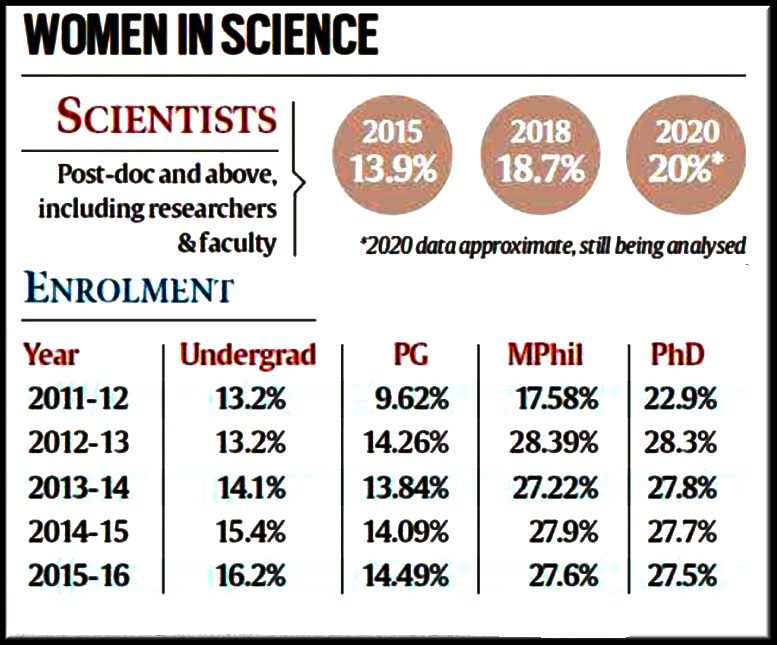Social Justice
Women Scientists in India
- 23 Aug 2022
- 5 min read
For Prelims: Department of Science and Technology, Vigyan Jyoti Programme, Science Technology Engineering and Mathematics (STEM), CURIE programme, GATI program.
For Mains: Representation of Women in Science and Associated Government Initiatives.
Why in News?
Data compiled by the Department of Science and Technology (DST) shows that 28% of participants in extramural Research & Development projects in 2018-19 were women, up from 13% in 2000-01 due to various initiatives taken by successive governments.
- The ministry aims to raise women’s participation in S&T to 30% by 2030.
- The recent appointment of Dr N Kalaiselvi as the first woman director general of Council of Scientific and Industrial Research (CSIR) underlined a significant trend of participation of women in science research.
What are the Key Findings?
- DST Findings:
- The number of women principal investigators in R&D had risen more than four times from 232 in 2000-01 to 941 in 2016-17.
- The percentage of women among researchers went from 13.9% in 2015 to 18.7% in 2018.
- While the overall data show an upward trend, women researchers in engineering and technology are fewer than in natural sciences, health and agriculture.
- The percentage of women researchers in the social sciences and humanities is, however, much higher at 36.4%.
- At the post-doctoral level, there are fewer women researchers than the global average.
- Participation (of women) is healthy till the postgraduate level.
- But there is a drop at the post-doctoral level, where most of the research takes place. Even though this too has increased, it is still far less than the 30% global average
- All India Survey on Higher Education (AISHE) 2019:
- According to AISHE, 53% participation of women in science education at Bachelor’s and 55% at Master’s levels respectively.
- But at doctoral level, women graduates at 44% lagged behind men at 56%.
- According to AISHE, 53% participation of women in science education at Bachelor’s and 55% at Master’s levels respectively.
What is the Overall State of Women Participation in the Science Sector?
- National Figure:
- Number of science researchers in India has doubled from 30,000 in 2014 to over 60,000 in 2022.
- Women’s participation is the highest in biotechnology at 40% and medicine at 35%.
- Department of Science and Technology:
- Out of the 97 scientists in the Department of Science and Technology (DST), 35 are women.
- The big achievement is that 11 out of 18 divisions in the DST are now headed by women, that is 61%, probably the largest percentage of women in leadership in any government department.
- Other Institutions:
- Coalition for Disaster Resilient Infrastructure (CDRI) has 18%, NIPER Hyderabad 21%, and the Defence Bio-Engineering and Electro-Medical Lab (DEBEL) in Bangalore has 33%.
- Delhi University has 33% women’s participation, while Tezpur University in Assam has 17%.
What Initiatives has the Government Taken for Women in Science?
- Gender Advancement for Transforming Institutions (GATI):
- The Gender Advancement for Transforming Institutions (GATI) was launched by the Department of Science & Technology (DST).
- It will develop a comprehensive Charter and a framework for assessing Gender Equality in STEM (Science, technology, engineering, and mathematics).
- In the first phase of GATI, 30 educational and research institutes have been selected by DST, with a focus on women’s participation in leadership roles, faculty, and the numbers of women students and researchers.
- Vigyan Jyoti Scheme:
- Vigyan Jyoti Scheme is launched by the Department of Science & Technology (DST).
- It is intended to create a level-playing field for the meritorious girls in high school to pursue Science, Technology, Engineering, and Mathematics (STEM) in their higher education.
- It also offers exposure for girl students from the rural background to help to plan their journey from school to a job of their choice in the field of science.
- Indo-US Fellowship for Women in STEMM (WISTEMM) program:
- Women scientists can work in research labs in the US.
- Consolidation of University Research for Innovation and Excellence in Women Universities (CURIE) Programme:
- Improving R&D infrastructure and establishing state-of-the-art research facilities in order to create excellence in S&T in women universities.





